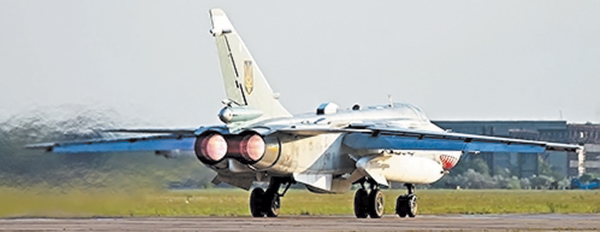
Back then, in July of 2014, pilots managed to land an aircraft engulfed in flames and deliver crucial intelligence just in time
Traditionally, whole brigades see aircraft crews off on their tasks. It makes no difference whether it is six o’clock in the morning or two o’clock at night, because nobody knows what the outcome of the flight will be. However, on July 2nd, 2014 no one came to see the crew off, because they were taking off from a foreign airfield. The pilots had a difficult task – to conduct reconnaissance over the area of occupied Sloviansk
– Straight ahead! – the crew commander ordered the navigator and turned on the afterburner.
Hope for a quiet flight was lost once the pilots entered the reconnaissance zone.
– Missile! – exclaimed the navigator and automatically switched on the shoot-off of heat flares. He was the first to notice the little white spot with daylight trace stretching behind.
– One more! – the adversary was obviously waiting for the Ukrainian aircraft: the shots were coming from a Man Portable Antiaircraft Missile System from the roof of a local high-rise. Concentration reached its maximum. Fortunately, the missiles missed their target. The infrared heads “engulfed” the aircraft, but lacked striking range.
Despite the mental strain, the task still had to be performed! The pilot proceeded along the route and began to register deployment sites of Russian invaders.
– Missiles!.. Two simultaneously!.. Moving towards us!.. – the navigator reported.
This time the missiles were launched from a distance of several hundred meters, so chances for rescue were slim to none.
– We avoided the first missile, where is the second one? – the navigator was thinking out loud.
The answer came at once. The aircraft began to shake, the hand wheel did not work, the display glimmered. Today, the pilot jokingly acknowledges: “It felt as though somebody hit the aircraft with a huge hand sledge”. But back then there was no time for laughter. The left engine caught fire and its temperature reached a critical low mark. Black clouds of smoke could be seen in the rear view mirrors. To top it all, the crew ran into air defence devices. There were only seconds to make a decision!
The pilot began a sharp descend. The objective was to hide from other missiles, because maneuvers and heat flares would be of no help. The crew commander had studied the area well which allowed him to conceal the aircraft, which was already engulfed in flames, using terrain features. Only then the crew managed to extinguish the fire.
The situation was complicated by that fact that the damaged aircraft began to lose fuel. But the important intelligence data could be processed only at one airfield in Poltava region which was 330 kilometers away. Was the risk worth it? The pilots did not need an answer. They knew what awaited them – 30 minutes of difficult flight. The pilot had only one concern:
– Navigator, do we have enough fuel?
– We should make it to the airfield, but we will have only one attempt to land…
After 200 kilometers of flight a reserve airfield emerged in sight. The pilots knew about it and could have finished the dangerous flight. However, after evaluating their odds they decided to proceed. Their destination was already on the horizon.
– We are on fire! – the navigator cried. Just as the aircraft was preparing to land, it caught fire for the second time.
Without exaggeration, the situation was critical: the 25-ton aircraft was engulfed in fire and there was no room for a mistake.
The landing strip was already in sight… The pilot leveled out the aircraft and started to descend. Finally, the wheels touched the landing strip. The aircraft stopped.
Doctors and fire trucks scurried around the combat craft. The pilots reported to the command about the successful completion of the mission. Later, the crew commander saw tens of missed calls and text messages from his wife: she already knew everything…
Three days later all Ukrainian mass media reported: “Sloviansk and Kramatorsk were liberated!” The crew was awarded with orders, but the pilots comprehended that they had risked for a reason only after they heard the news about the liberated towns of Ukraine. Delivered images of enemy defence helped Ukrainian defenders to enter Sloviansk and Kramatorsk.
Even the aircraft refused to “give up”: less than in three months it was brought back into service. At the end of August, the aircraft was already conducting flights.
Nowadays, the crew commander holds the rank of Lieutenant Colonel with the functions of brigade commander. He says that he is still tough with his subordinates. He tells us that striking aviation is the most powerful one, as was demonstrated by his unit back in 2014.
– We provided a lot of help to infantry forces in battles. Everyone I currently meet thank us. There were situations when our forces were encircled. We came to their aid. We fired at targets – fragments of enemy tanks and guns flew in every direction. The main thing is that it was all done for a cause… Fortunately, nowadays considerable attention is paid to our brigade. We underwent exercises, an intensive training of staff is in progress, and we continuously improve the skills of many pilots. Modern Ukrainian pilots must be able to fly at low altitudes and “hide behind trees”, and this is not an easy thing to do. One needs exceptional skills, - the officer says.
Anastasiia OLEKHNOVYCH